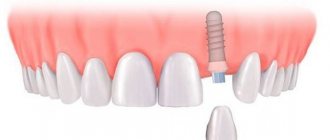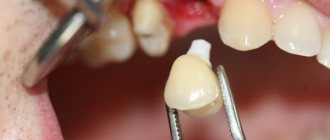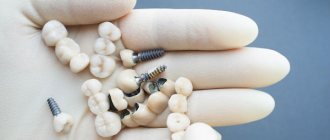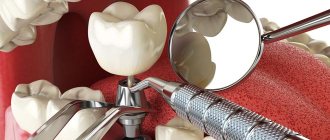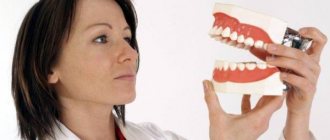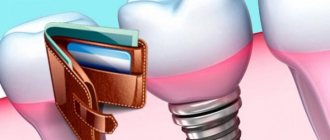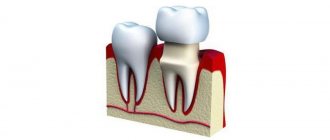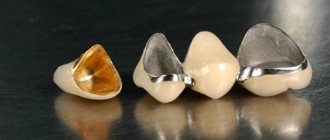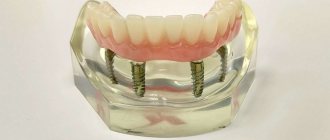Modern methods in dentistry, including the latest technologies in implantation, can solve almost any problem, including complete absence of teeth. However, installing a large number of implants entails large financial and time costs. It is not surprising that a system that requires only four implants and reduces surgical time can be considered the most optimal option for most patients. Alexander Pavlovich Akhtanin, an orthopedist-implantologist with more than 30 years of experience, the chief physician of the Family Dentistry clinic, talks about the features of all-on-4, or “all-on-four” implantation.
What is All-on-4 implantation?
“All on four” implantation is the fixation of fixed dentures on four implants installed in the upper or lower jaw. The prosthesis is fixed on implants using special screws, which ensures good stabilization. Only a doctor can remove such a prosthesis; this usually happens twice a year - for inspection and necessary preventive measures. The patient’s attendance at such preventive examinations is strictly mandatory, as this prevents the development of possible complications.
Attaching dentures to implants
Types of fastenings when restoring all teeth on four implants
No less important than the correct calculation when calculating the installation of implants is the method of attaching them to the surface of the denture. There are the following fixation methods:
- Screw fixation. The prosthesis frame is attached directly to the implant using a screw. This method of fastening is good because it is possible to remove the prosthesis. The fastening screw is made of hypoallergenic metal and is distinguished by high-quality surface treatment.
- Ball-shaped fasteners are used in cases where, due to the patient’s anatomy, it is impossible to place large implants or for better hygiene the patient prefers to be able to occasionally remove the prosthesis. For more thorough care of the area around the implants and the prosthesis itself from the inside. The reverse part of the prosthesis is a round cavity into which the spherical top of the implant fits; the locking mount is additionally sealed with a rubber gasket. This fastening makes it possible for the patient to easily remove the prosthesis, while at the same time firmly fixing it in the oral cavity. The disadvantages of the spherical fastening method come out of its advantages - due to the need to periodically remove the prosthesis, the rubber gaskets must be periodically changed. Typically once a year. Also, the disadvantages include the not always uniform distribution of the load under the prosthesis, which leads to slow bone atrophy and the need to reline the prosthesis.
- Beam fastening. It involves connecting all implanted implants using a metal alloy beam, onto which artificial teeth are attached using micro-locks. Reliable fixation and uniform distribution of load over the entire surface of the prosthesis distinguish this option for tooth restoration.
Source: starsdent.ru
What are the indications for All on Four dental implants?
One of the indicators can be the small volume of bone tissue in both the upper and lower jaws. It is especially problematic with the required volume of bone tissue for implantation in the chewing sections, since in the absence of teeth for quite a long time, the volume of bone tissue in these sections decreases, and this happens even when using removable dentures. In order to install the number of implants required for fixing fixed prostheses (from 6 to 10), a preliminary operation is required to restore the required bone volume. Only after this are implants installed, and after some time (from three to eight months) prosthetics are performed on them.
Advantages and disadvantages of dental bridges on implants
Advantages and disadvantages of dental bridges on implants
Bridges that are fixed on implants are widespread due to a number of undeniable advantages:
- during installation there is no need to grind down healthy abutment teeth ;
- titanium analogues of roots are an order of magnitude more stable than natural dental units;
- the service life of structures on implants is many times longer;
- imitation of natural load on the bone;
- more reliable connection of the prosthesis to the jaw;
- even if the last teeth in a row are lost, they can be restored;
- simplified care;
- Can be used in cases of complete edentia or loose teeth ;
- significant savings compared to installing single crowns on implants.
However, it is worth considering that implantation is a serious surgical operation that requires not only high-quality materials, but also innovative technology, as well as the skill of the dentist. These factors determine the high cost of prosthetics, but owners of bridge structures assure that the result is completely worth the money spent.
What are the advantages of dental prosthetics with 4 implants?
If we compare the “All on Four” technique with the use of removable dentures, the difference will be that in the first case the risks of mucosal injury, bone loss, as well as difficulties with fixation and correction are reduced to zero.
A patient with a removable denture experiences discomfort both functionally and socially. Most people who use removable dentures experience some self-doubt, and sometimes even inferiority in their social status. Also, when installing “all on four” implants, as already mentioned, there is no need for a large number of implants. Due to the fact that these four implants are installed in certain positions in relation to each other: when implanting the front teeth - straight, and in the lateral teeth - at an angle of 35º to 45º, and also by creating a large distance between them, the chewing load is adequately distributed and is redistributed during operation. A small number of implants simplifies the operation, making it faster and more predictable, while ensuring excellent results.
The result of All-on-4 implantation at the Family Dentistry clinic
In what cases and how is prosthetics performed on four implants?
This method is used in cases where the patient has lost many teeth, or when he has none at all. This technology was first used in 1998 by Portuguese dentist Paulo Malo.
This method of dental prosthetics is based on the following principles:
- Four root-shaped implants are used as support for the prosthesis.
- Artificial roots located on the sides are implanted into the bone not vertically, but at an angle of about 45 degrees.
- Bone tissue augmentation is either not performed at all, or is performed simultaneously with implantation.
- The prosthesis is installed on the same day as the implantation; screws are used to secure the structure.
- This implantation method uses 3D modeling.
Prosthetics on 4 implants
Unlike traditional crown bridges, dentures installed on 4 implants are removable, but to do this you need to unscrew the fixing screws. Only a doctor can do this. According to the rules of care, the procedure for removing dentures for the purpose of preventive cleaning should be carried out twice a year.
“all-on-4 prosthetics” method is a one-stage implantation - tooth extraction, implantation and bridge installation are carried out in one day. In some cases, all procedures may take several days.
In what cases is all-on-4 prosthetics used?
Installation of a bridge on four implants has the following indications:
- complete absence of dentition;
- presence of teeth that cannot be treated;
- sufficient bone volume;
- impossibility of artificial bone augmentation.
As a rule, the installation of a bridge on four implants is prescribed either when the patient has completely lost teeth, or when all his existing teeth must be removed. At the same time, this method of prosthetics can also be used if the bottom of the maxillary cavity is located close to the upper jaw, which greatly complicates the use of conventional implantation.
This method of prosthetics also has its contraindications, namely:
- Hemophilia and other diseases that impair blood clotting.
- Diabetes.
- Cardiovascular pathologies.
- Immune system problems.
- Psychoneurological diseases.
How is prosthetics performed on 4 implants?
Implantation using this method includes the following steps:
- The preparatory stage, at which a complete diagnosis of the patient’s health condition is carried out to exclude contraindications. We treat diseased teeth and remove teeth that cannot be treated. Various inflammatory processes in the oral cavity are also eliminated. For diagnosis, methods such as blood tests, radiography and tomography are used.
- Introduction of implants into bone tissue. This procedure is performed under local anesthesia. The implants are installed with a specific orientation relative to each other. Artificial roots for dentures of anterior teeth are installed vertically. Implants for lateral teeth are placed at an angle of 45 degrees. After the implants are implanted, an impression is made, from which a permanent bridge is then made.
- Once the artificial roots are in place, a temporary bridge made of acrylic polymer material is attached to them.
- The duration of the process of integrating implants with bone is about four months.
- After osseointegration is completed, the temporary prosthesis is removed and a permanent one is placed in its place.
The time of implant integration is a very crucial period for both the doctor and the patient. It is at this stage that the risk of rejection is greatest. Since the line between the natural postoperative state of the oral cavity and signs of complications is very blurred, the patient should regularly visit the doctor for timely detection of symptoms of pathology.
To select the exact location of dental implants and their angle of inclination, 3D modeling is used, the initial data for which are the results of computed tomography. In this case, the program takes into account the characteristics of the bone tissue of the jaw and the individual characteristics of the anatomical structure - in particular, the localization of nerves and the location of the maxillary cavities.
A characteristic feature of this technology is the inclined position of the implants installed on the flanks. This provides a sufficiently large area of contact between the implant and the bone, which significantly improves the fixation of the artificial root and the distribution of the load during chewing. In addition, the inclined installation of implants avoids the need for a sinus lift if the maxillary cavity is too close, since the artificial root is not directed directly at the nasal sinus, but to the side.
All-on-4 prosthetic technology. Panoramic radiography
During the period of integration of the implant with the jawbone, it is important to carefully observe the requirements for the care of the temporary bridge. It is necessary to observe hygiene rules and avoid excessive loads on the structure. Violation of care standards can lead to peri-implantitis - an inflammatory process in the tissues adjacent to the artificial root, and, as a result, to implant rejection. Excessive loads may simply cause the structure to break.
What types of prostheses are used when implanting All-on-4?
For “All on Four” implantation, fixed prostheses are always used, which, however, can be called conditionally removable, because they are fixed with special screws, but at the same time they are fixed rigidly. The patient is not able to remove them while wearing them; I repeat, this can only be done by a doctor for regular checks.
Designs of this type have stood the test of time, showing excellent clinical results. The reliability of work done using this technology is beyond doubt. A large number of patients choose this technology and are very satisfied.
Insert a dental crown
Provided the tooth root is intact and reliable, restoration is possible with a crown, which reliably protects the tooth from further destruction.
Modern prosthetics with crowns can be divided into several types:
A popular type of dental crown is characterized by practicality, versatility, durability and reasonable price.
Highly aesthetic and durable crowns for anterior and anterior teeth. Zirconium crowns differ in their manufacturing method, materials and more accurately convey the naturalness of teeth.
For example, if such a crown is brought to a light source, then even the naked eye can see the natural structure of the new tooth.
What does it mean?
Of course, it is not necessary to demonstrate this ability of a tooth in everyday life.
